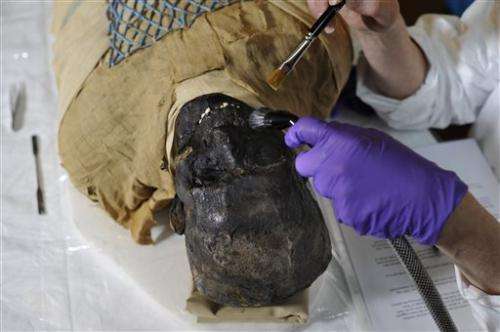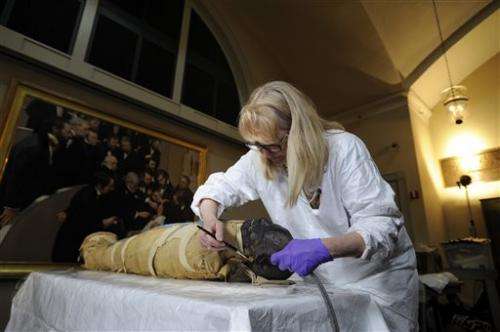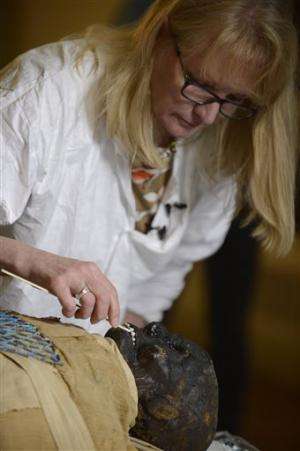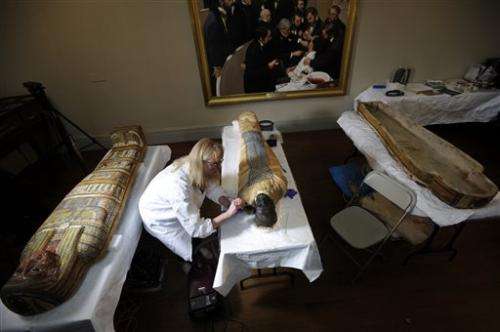Mimi Leveque, a freelance conservator, cleans Padihershef, a 2,500-year-old Egyptian mummy at Mass General Hospital in Boston, Friday, June 7, 2013. Padihershef, who has made MGH his home since 1823, was a 40-year old stonecutter in the necropolis in Thebes, an ancient city on the west bank of the Nile. (AP Photo/Gretchen Ertl)
A 2,500-year-old Egyptian mummy came out of his coffin Friday to undergo cleaning and restoration at Massachusetts General Hospital.
The mummy known as Padihershef has been on display at the third oldest general hospital in the United States since it received him as a gift from the city of Boston in 1823 as a medical oddity. He is one of the first complete mummies brought to the United States.
A conservator trained in restoring ancient artifacts removed him from his coffin Friday and began using cotton swabs dabbed in saliva to wipe away salt deposits from his face. The salt has been slowly seeping out of his tissue, a result of the mummification process. Experts are also expected to do minor repair and stabilization work on his coffin.
Mimi Leveque, a freelance conservator, cleans Padihershef, a 2,500-year-old Egyptian mummy at Mass General Hospital in Boston, Friday, June 7, 2013. Padihershef, who has made MGH his home since 1823, was a 40-year old stonecutter in the necropolis in Thebes, an ancient city on the west bank of the Nile. (AP Photo/Gretchen Ertl)
The whole process is expected to take three days.
The mummy and his coffin will then be moved to a special horizontal case in which they will lie next to each other in the Ether Dome, a surgical amphitheater where William T. G. Morton demonstrated the first public surgery using anesthetic on Oct. 16, 1846.
Mimi Leveque, a freelance conservator, cleans Padihershef, a 2,500-year-old Egyptian mummy at Mass General Hospital in Boston, Friday, June 7, 2013. Padihershef, who has made MGH his home since 1823, was a 40-year old stonecutter in the necropolis in Thebes, an ancient city on the west bank of the Nile. (AP Photo/Gretchen Ertl)
Padihershef was a 40-year-old stonecutter in the necropolis in Thebes, an ancient city on the west bank of the Nile, in what is today's Luxor. He was a gift from a Dutch diplomat who was happy with the city of Boston's hospitality, officials said.
No one knows exactly how he lived or died. Experts are exploring those questions through a conservation project supported by the hospital and donors.
Mimi Leveque, a freelance conservator, cleans Padihershef, a 2,500-year-old Egyptian mummy at Mass General Hospital in Boston, Friday, June 7, 2013. Padihershef, who has made MGH his home since 1823, was a 40-year old stonecutter in the necropolis in Thebes, an ancient city on the west bank of the Nile. (AP Photo/Gretchen Ertl)
In March, he was removed from his case and transported on a patient stretcher to the imaging suites in the hospital, where technicians subjected him to full body X-ray and CT scanning. Experts were surprised to see a broom handle embedded at the base of his head and running through his torso in what likely was a crude attempt to stabilize his head. There are no records to indicate when the repair was done and by whom, the hospital said on its website.
The study was intended to produce images that could be compared with those gleaned from exams conducted in 1931 and 1976 and to determine the condition of his bones. Those earlier tests revealed his bones had interrupted growth lines that indicate a severe childhood illness that resulted in stunted growth.
© 2013 The Associated Press. All rights reserved.























